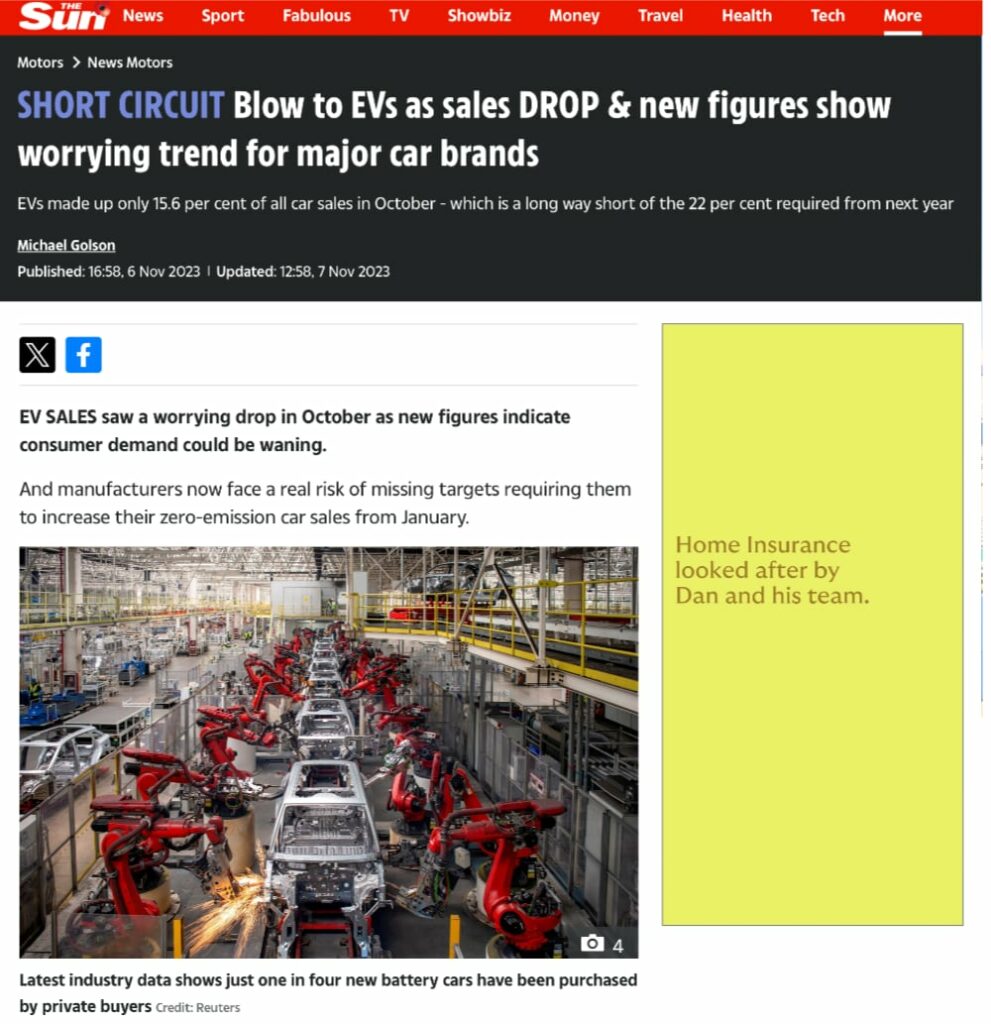Auto Dealers Double Down On Opposition To EV Sales Targets

Table of Contents
Financial Concerns and Infrastructure Gaps
Auto dealers face substantial financial hurdles in adapting to the rapid shift towards EVs. The high upfront investment costs, coupled with uncertainties in consumer demand and insufficient charging infrastructure, create a complex and challenging landscape.
High Upfront Investment Costs for Dealerships
Meeting ambitious EV sales targets requires significant capital expenditures for dealerships. These costs are not trivial and represent a major obstacle for many businesses.
- Upgrading facilities for EV servicing: Dealerships need specialized tools and training to service EV batteries, electric motors, and other components, representing a considerable investment.
- Specialized training for technicians: Existing technicians require extensive retraining to work on EVs, adding to the overall cost. This includes training on diagnostics, repair procedures, and safety protocols specific to EVs.
- Costs associated with installing fast chargers: Installing fast-charging stations requires significant upfront investment, including the purchase and installation of chargers, grid upgrades, and potentially additional land space.
Industry estimates suggest that the average cost of EV infrastructure upgrades for a dealership can range from $50,000 to well over $200,000, depending on size and location. This financial burden is a major deterrent for many dealers, particularly smaller, independent dealerships.
Lack of Consumer Demand in Certain Markets
While EV adoption is rapidly increasing in some regions, other markets lag significantly. This disparity creates challenges for dealers in areas with lower consumer interest in electric vehicles.
- Geographic limitations: Rural areas often lack the necessary charging infrastructure, impacting consumer confidence and willingness to purchase EVs.
- Consumer awareness and education: Many consumers remain uncertain about EVs, their capabilities, and the charging process, hindering widespread adoption. Targeted education campaigns are crucial to bridge this knowledge gap.
- Affordability concerns: The higher initial purchase price of EVs compared to gasoline-powered vehicles remains a significant barrier for many potential buyers.
Data from various automotive market research firms consistently shows significant regional variations in EV sales, with some areas exhibiting high adoption rates and others lagging far behind. These disparities highlight the need for regionally tailored strategies to support EV adoption.
Insufficient Charging Infrastructure
The lack of widespread and reliable charging infrastructure is a major obstacle to EV adoption and adds further pressure on dealerships.
- Range anxiety: Concerns about running out of charge before reaching a charging station remain a significant psychological barrier for many potential EV buyers.
- Charging time: The time it takes to fully charge an EV, especially using slower chargers, can be a deterrent, especially compared to the quick refueling times of gasoline-powered vehicles.
- Lack of convenient charging locations: The absence of convenient and readily accessible charging stations in residential areas, workplaces, and along major travel routes restricts EV usage and adoption.
Numerous studies and reports have highlighted the urgent need for significant investment in charging infrastructure to support the widespread adoption of EVs. This infrastructure development is crucial not only for consumers but also for the success of auto dealerships investing in EV sales.
Concerns Regarding Government Regulations and Policy Uncertainty
The rapid pace of change in government regulations surrounding EVs adds to the challenges faced by auto dealers. Uncertainty, lack of support, and direct competition from other manufacturers create a volatile business environment.
Rapidly Changing Government Regulations
Frequently evolving EV mandates make it difficult for dealers to plan long-term investments and strategies.
- Uncertainty in future regulations: The unpredictable nature of government policies creates uncertainty about future demand for EVs, making it difficult for dealers to justify significant upfront investments.
- Difficulty in long-term planning: The constant changes in regulations make long-term financial planning and investment decisions incredibly challenging, potentially impacting the stability of dealerships.
- Unpredictable consumer demand influenced by policy changes: Changes in government incentives or mandates can significantly impact consumer demand for EVs, creating volatility in the market.
For instance, recent changes in tax credits or emissions standards have directly impacted dealer investment plans and sales strategies, demonstrating the need for more stable and predictable regulatory frameworks.
Lack of Clarity and Support from Government
Dealers often feel a lack of sufficient government support and guidance during the transition to EVs.
- Inadequate incentives for dealers: While some incentives exist, many dealers feel that they are insufficient to offset the significant costs associated with transitioning to EV sales.
- Insufficient funding for infrastructure: Government funding for charging infrastructure development has often been deemed inadequate to meet the rapidly growing demand.
- Bureaucratic hurdles in obtaining permits and subsidies: The process of obtaining permits and accessing government subsidies for EV infrastructure upgrades can be complex and time-consuming.
Clearer guidelines, streamlined processes, and increased financial support from government are crucial to alleviate the burdens faced by auto dealers.
Competition from Direct-to-Consumer EV Manufacturers
The rise of direct-to-consumer EV manufacturers poses a significant competitive threat to traditional dealerships.
- Loss of market share: Direct-to-consumer models bypass dealerships, leading to a potential loss of market share and revenue for traditional dealers.
- Reduced profitability: Competition from companies with lower overhead costs can impact the profitability of dealerships.
- Decreased influence over sales strategies: Dealerships have less control over sales processes and pricing when competing against direct-to-consumer models.
Tesla's success, for example, showcases the potential threat posed by these direct-to-consumer models, forcing traditional dealers to adapt to a rapidly changing market.
Alternative Solutions and Proposed Compromises
Addressing the concerns of auto dealers requires a collaborative approach involving phased implementation, increased government support, and open communication between all stakeholders.
Phased Implementation of EV Sales Targets
A gradual increase in EV sales targets allows dealerships sufficient time to adapt to the changing market.
- Realistic timelines: Setting achievable targets based on market realities and the capacity of dealers to adapt is crucial.
- Considering regional differences: Recognizing the varying levels of EV adoption across different regions is vital for setting appropriate targets.
- Incremental investment strategies: A phased approach allows dealers to make incremental investments, reducing the financial burden and risk.
Increased Government Support and Incentives
Significant financial support and training programs are vital for dealers to successfully transition to EVs.
- Tax credits: Increased tax credits for dealerships investing in EV infrastructure and training can significantly reduce the financial burden.
- Grants and subsidies: Government grants and subsidies can help offset the costs of upgrading facilities and installing charging stations.
- Training programs for technicians: Investing in comprehensive training programs for technicians is crucial to ensure skilled labor is available to service EVs.
Collaboration Between Government, Manufacturers, and Dealerships
Open communication and shared responsibility are essential for a successful transition to EVs.
- Open communication: Regular dialogue between government agencies, auto manufacturers, and dealerships can help address concerns and find mutually beneficial solutions.
- Shared responsibility: All stakeholders need to share the responsibility for creating a supportive ecosystem for EV adoption.
- Industry-wide strategies: Collaborative efforts can lead to the development of effective industry-wide strategies for addressing the challenges of EV adoption.
Conclusion
Auto dealers' opposition to mandated EV sales targets stems from genuine concerns about the financial burdens, infrastructural limitations, and regulatory uncertainties they face. The transition to electric vehicles is undeniably crucial for environmental sustainability, but a collaborative and phased approach, with increased government support and realistic timelines, is essential. Ignoring the concerns of auto dealers will not facilitate a smooth transition; rather, it risks hindering the widespread adoption of EVs. A pragmatic approach to EV sales targets, one that considers the financial realities and infrastructural needs of dealerships, is crucial for the future of the automotive industry. Policymakers must actively engage with the automotive dealer community to develop sustainable solutions that benefit both the environment and the economic viability of the industry.

Featured Posts
-
 Move Over Quinoa Introducing The It Crop Of The Future
Apr 29, 2025
Move Over Quinoa Introducing The It Crop Of The Future
Apr 29, 2025 -
 How You Tube Caters To Older Viewers Entertainment Needs
Apr 29, 2025
How You Tube Caters To Older Viewers Entertainment Needs
Apr 29, 2025 -
 March 3 2025 Nyt Strands Guide To Completing The Puzzle
Apr 29, 2025
March 3 2025 Nyt Strands Guide To Completing The Puzzle
Apr 29, 2025 -
 Lynas Rare Earths Texas Refinery Project A Plea For Us Financial Aid
Apr 29, 2025
Lynas Rare Earths Texas Refinery Project A Plea For Us Financial Aid
Apr 29, 2025 -
 9 Billion Dow Project Delayed In Alberta Due To Tariff Impacts
Apr 29, 2025
9 Billion Dow Project Delayed In Alberta Due To Tariff Impacts
Apr 29, 2025
Latest Posts
-
 Convicted Cardinal Fights For Conclave Voting Rights
Apr 29, 2025
Convicted Cardinal Fights For Conclave Voting Rights
Apr 29, 2025 -
 Cardinal Maintains Voting Eligibility Despite Conviction
Apr 29, 2025
Cardinal Maintains Voting Eligibility Despite Conviction
Apr 29, 2025 -
 Controversial Cardinal Fights For Conclave Inclusion
Apr 29, 2025
Controversial Cardinal Fights For Conclave Inclusion
Apr 29, 2025 -
 Convicted Cardinal Seeks Role In Next Papal Election
Apr 29, 2025
Convicted Cardinal Seeks Role In Next Papal Election
Apr 29, 2025 -
 Eligibility Of A Convicted Cardinal To Participate In The Papal Conclave
Apr 29, 2025
Eligibility Of A Convicted Cardinal To Participate In The Papal Conclave
Apr 29, 2025
